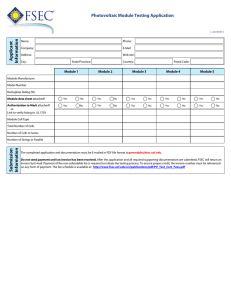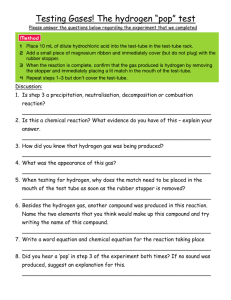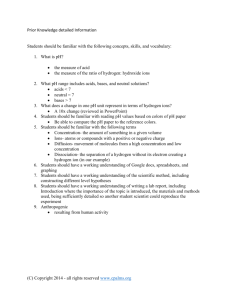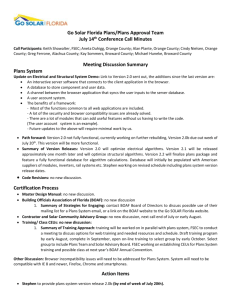Hydrogen Research at Florida Universities EXECUTIVE SUMMARY NASA Grant NAG 3-2751
advertisement
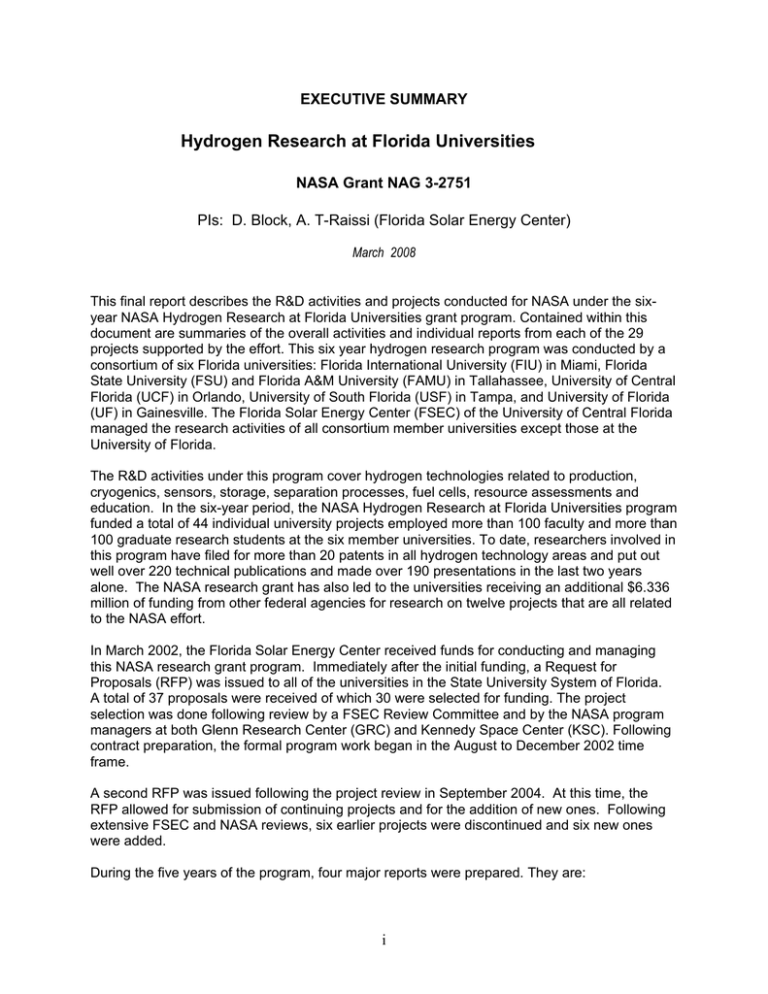
EXECUTIVE SUMMARY Hydrogen Research at Florida Universities NASA Grant NAG 3-2751 PIs: D. Block, A. T-Raissi (Florida Solar Energy Center) March 2008 This final report describes the R&D activities and projects conducted for NASA under the sixyear NASA Hydrogen Research at Florida Universities grant program. Contained within this document are summaries of the overall activities and individual reports from each of the 29 projects supported by the effort. This six year hydrogen research program was conducted by a consortium of six Florida universities: Florida International University (FIU) in Miami, Florida State University (FSU) and Florida A&M University (FAMU) in Tallahassee, University of Central Florida (UCF) in Orlando, University of South Florida (USF) in Tampa, and University of Florida (UF) in Gainesville. The Florida Solar Energy Center (FSEC) of the University of Central Florida managed the research activities of all consortium member universities except those at the University of Florida. The R&D activities under this program cover hydrogen technologies related to production, cryogenics, sensors, storage, separation processes, fuel cells, resource assessments and education. In the six-year period, the NASA Hydrogen Research at Florida Universities program funded a total of 44 individual university projects employed more than 100 faculty and more than 100 graduate research students at the six member universities. To date, researchers involved in this program have filed for more than 20 patents in all hydrogen technology areas and put out well over 220 technical publications and made over 190 presentations in the last two years alone. The NASA research grant has also led to the universities receiving an additional $6.336 million of funding from other federal agencies for research on twelve projects that are all related to the NASA effort. In March 2002, the Florida Solar Energy Center received funds for conducting and managing this NASA research grant program. Immediately after the initial funding, a Request for Proposals (RFP) was issued to all of the universities in the State University System of Florida. A total of 37 proposals were received of which 30 were selected for funding. The project selection was done following review by a FSEC Review Committee and by the NASA program managers at both Glenn Research Center (GRC) and Kennedy Space Center (KSC). Following contract preparation, the formal program work began in the August to December 2002 time frame. A second RFP was issued following the project review in September 2004. At this time, the RFP allowed for submission of continuing projects and for the addition of new ones. Following extensive FSEC and NASA reviews, six earlier projects were discontinued and six new ones were added. During the five years of the program, four major reports were prepared. They are: i 1. A report for the first year's effort was completed by FSEC in November 2003 and sent to the NASA program managers at GRC and KSC. This 2003 report contained individual reports for each of the funded projects. 2. A report containing all the projects for the activities at the end of year two was prepared for the NASA GRC program manager in November 2004. 3. Following a NASA GRC management change, the November 2004 report was updated and sent to NASA GRC in June 2005. This report was named the project report for FY 2003 which then was published as NASA Contract Report #2006-214326. 4. A report for the third year for FY 2004/2005 was prepared and sent to NASA GRC in June 2006. Again this report contained all the projects that had been worked on. 5. The final report that contains the activities from June 2006 to December 2007 with published date of February 2008. During the initial year of the project, the NASA managers requested that periodic review meetings be held in order to review the projects goals, the benefits to NASA and the results obtained. The project review meetings were held at all the participating universities and covered, in addition to project reviews, tours of the host university labs and facilities. The review meetings were then held as follows: 1. During the first year, two project review meetings were held, one on January 14-16, 2003 at the University of South Florida in Tampa and one on August 12-15, 2003 at the University of Florida in Gainesville. 2. During the second year, the spring project review meetings were held on March 3-4, 2004 at Florida State University in Tallahassee and March 30-31, 2004 at the University of Central Florida in Orlando and the fall meeting on September 21-22, 2004 at the Florida Solar Energy Center in Cocoa. 3. The final two review meetings were held on May 11-15, 2005 at the University of Florida in Gainesville and on November 1-4, 2005 at the Florida Solar Energy Center in Cocoa. Each of the review meetings took 3 to 4 days due to the large number of project presentations. Each project presentation was given 20 minutes for the power point slides followed by a 10minute question and answer period. Following all the presentations at each review meeting, FSEC program managers met with the five to six NASA reviewers that had attended the meeting and discussed each project. These discussions concerned the project's need, benefits and results and included recommended changes in the project activity. Over the period of the grant all project changes or re-directions occurred as a result of the outcomes of the review meetings. The last program change occurred in September 2006 when the fourth and last funding increment was received from NASA GRC. At this time, the program was to place more emphasis on the development of fuel cells. Thus, this final report includes 27 projects which were ongoing for the last two years. As a final comment on the projects that were conducted, it is noted that each of the university participants have made educational activities a major part of their research program. The educational component involved the research projects for graduate student MS and PhD theses as part of the project deliverables. The FSEC program expanded the education effort to include K-12 education and public outreach activities. Detailed information on each of the individual projects is also available ii at: http:// www.fsec.ucf.edu/hydrogen/new/research/funded_nasa.htm and http://www.hydrogenresearch.org. The NASA Hydrogen Research at Florida Universities program has demonstrated that six Florida universities within the State University System can effectively and collaboratively address a major issue of national interest, hydrogen energy. Each of our partner universities identified areas of expertise and interest while contributing to the overall success of the program. A one-page summary of each of the projects is presented in the next section followed by the complete individual final project reports. A brief description of the final projects presented by hydrogen technology areas are as follows: Hydrogen Production – In Florida, NASA KSC and Cape Canaveral Air Force Station will eventually require local production facilities because of economics, transportation safety and quantity requirements. Thus, local hydrogen production was a major task of the program. Eight projects were carried out under this general heading: • • • • • • • • Genetic Engineering to Enhance Biological Hydrogen Production - Self, W., Ganyc, D., Halvorsen, L. (UCF) Hydrogen Production from Used Lube Oils - T-Raissi, A., Ramasamy, K. (FSEC) Hydrogen Production via Solar Thermochemical Water Splitting – T-Raissi, A., Huang, C., Muradov, N. (FSEC) Improved Hydrogen Yield from Florida Specific Biomass Gasification Using a Pilot Scale Gasification Unit - Srivastava, R. (FIU) Local Hydrogen Production via Catalytic Reformation of Fossil and Renewable Resources - Muradov, N., Smith, F. (FSEC) Photoelectrochemical Water Splitting for Hydrogen Production Using Multiple Bandgap Combination of Thin-Film Photovoltaic Cells and Photocatalyst – Dhere, N. (FSEC) System Analysis of Hydrogen Production and Utilization at KSC - T-Raissi, A., Elbaccouch, M., Ramasamy, K., Baik, J. (FSEC) Thermo Catalytic H2 Production via Oxygen-Free Methane Aromatization - Wolan, J., Stefanakos, E., Kababji, A. (USF) Fuel Cells – Fuel cells offer new aircraft power options that can meet NASA’s vehicle requirements. Of the five types of fuel cells, proton exchange membrane (PEM) fuel cells are the leading candidate for next generation space and aircraft power due to their high specific power output. This task addressed several innovative PEM fuel cell technologies as follows: • • • • Compact, Lightweight and Optimized Fuel cells for Space or Aircraft Power - Fenton, J, Choi, P., Bonville, L., Kunz, R. (FSEC) Hydrogen-Powered Aeropropulsion: Compact, Lightweight and Efficient Fuel Cells for Space Power - Linkous, C., Pearman, B., Hall, D., Slattery, D., Baik, J. (FSEC) Integrated Fuel Cell Test Bed Facility - Slattery, D., Bonville, L., Fowler, R. (FSEC) Modeling and Optimization of Fuel Cell Systems for Aircraft Applications - Ordonez, J., Lungo, C (FAMU) Hydrogen Sensors – Cost effective hydrogen sensor technologies that can deliver detection selectivity and sensitivity, dependability and durability, stability and reproducibility, and applicability in cryogenic LH2 environment are needed. Projects conducted in this area were: iii • • • • Gas Permeable Chemochromic Compositions for Hydrogen Sensing - Mohajeri, N., Muradov, M., Bokerman, G., T-Raissi, A., Captain, J., Peterson, B., Whitten, M. (FSEC) Highly Selective Nano-Mems Low Temperature Hydrogen Sensor- Seal, S., Cho, H. (UCF) Surface Acoustic Wave (SAW) Sensors for Hydrogen and Other Gas Detection Bhethanabotla, V. (USF) Wireless Passive Sensors and Systems for Physical Sensors and Hydrogen Sensing Applications - Malocha, D. (UCF) Hydrogen Storage and Liquefaction – Use of hydrogen as an energy carrier and fuel for spaceport and vehicle applications requires that it be stored and transported. New and innovative technologies are needed for higher energy density and safe H2 storage and transport. The storage and liquefaction projects were: • • • • • • • A Reliable, Efficient and Compact Reverse Turbo Brayton Cycle Cryocooler for Storage and Transport of Hydrogen in Spaceport and Space Vehicle Applications - Chow, L., Kapat, J., Chen, Q., An, L., Wu, T., Sundaram, K., Ham, C., Dhere, N. (UCF) Ammonia-Borane Complex for Hydrogen Storage - Mohajeri, N., T-Raissi, A., Ramasamy, K., Adebiyi, O., Bokerman, G. (FSEC) Liquid Hydrogen Storage at Kennedy Space Center - Gu, L., Block, D., Bokerman, G., TRaissi, A., Basarkar, M. (FSEC) Numerical Simulation Model for Thermo-Fluid Analysis of Cryogenic Storage Systems with Zero Boiloff - Rahman, J., Ho, S. (USF) Prototype and Simulation Model for a Magneto-Caloric Refrigerator - Bhansali, S., Rahman, M., Kim, S., Ghirlanda, S., Hernandez, C., Adams, C., Bethala, B., Rosario, S., Sambandam, S. (USF) Smart Porous Metal-Organic Frameworks (MOFs) for Hydrogen Recovery and Storage Eddaoudi, M., Zaworotko, M., Space, B., Eckert, J., T-Raissi, A., Mohajeri, N. (USF/FSEC) Zero-Boil-Off Liquid Hydrogen Storage Tanks - Baik, J. (FSEC) Cryogenics – NASA Glenn research engineers have been working in the field of high-energy, high-density cryogenic propellants for over two decades. This basic research area focused on developing handling capabilities and defining and measuring low temperature performance characteristics of cryogenic propellants. • • • Development of Cryogenic Shape Memory Actuator Materials for Switches, Seals and Valves - Vaidyanathan, R. (UCF) Densified LH2 and LO2: Transport Properties and Density - Van Sciver, S. (FSU) Experimental and Numerical Investigations of Cryogenic Multiphase Flow - Van Sciver, S. (FSU) Hydrogen Separation – Hydrogen is lost by NASA operations due to transfer, boil off and purging. In addition, prior to filling lines with liquid hydrogen, they must be precooled with liquid helium and then the helium is purged. Recovery of this lost hydrogen and helium could lead to substantial savings and led to these two projects. • Ceramic Membranes of Mixed Ionic-Electronic Conductors for Hydrogen Separation Elbaccouch, M., T-Raissi, A., Linkous, C., Mohajeri, N. (FSEC) iv • Metal Hydrides for Hydrogen Separation, Recovery and Purification - Hampton, M., Slattery, D. (UCF/FSEC) Hydrogen Education and Outreach • Hydrogen Education and Outreach – Schleith, S., Hall, P., Henzmann, A., Block, D. (FSEC) v
